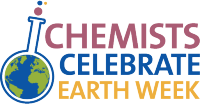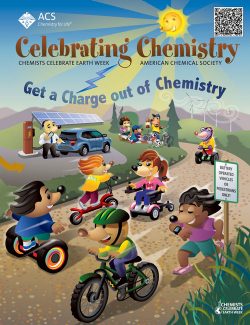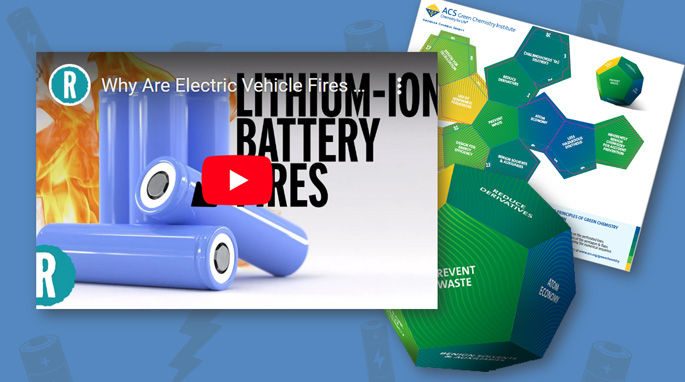Educational Resources
CCEW 2024 Get a Charge out of Chemistry
Find educational resources for this year's Chemists Celebrate Earth Week theme and other materials for your event, including outreach activities, activities, articles, and videos.

K-8 Resources
Related to the CCEW 2024 theme of batteries and their role in making renewable energy sources such as solar, wind, and hydropower successful.
Adventures in Chemistry
- Metals—They’re Electrifying
Find out whether aluminum foil, a popsicle stick, and a metal coin can conduct electricity. - Great Electron Ripoff
Explore static electricity between two pieces of tape and between a balloon and a piece of a plastic grocery bag.
From Middle School Chemistry: Big Ideas about the Very Small
- Carbon Dioxide Can Make a Solution Acidic
Students will be able to explain that carbon dioxide from any source reacts chemically with water to form carbonic acid. They will also be able to use the color changes of universal indicator to monitor the changing pH of a solution during a chemical reaction. - Natural Resources & Synthetic Materials
Students will be able to find and analyze information to describe that chemical processes are used to convert natural resources into synthetic materials and products. They will also be able to give examples of how the production of synthetic products has impacts, both positive and negative, for society. - Protons, Neutrons, and Electrons (Simulations and Videos)
Try the interactive animations to learn the basics about protons and electrons. Then do a couple of static electricity experiments to see what happens when you give or take electrons from an item.
Classroom Resources
From the American Association of Chemistry Teachers (AACT)
Consider joining AACT for access to many more resources for chemistry teachers year-round and connect with a community of K–12 chemistry teachers.
High School:
- Activity: What Powers Your World
- Animation: Galvanic Cells
- Lab: Electrolysis of Water
- Lab: Four-Way Galvanic Cell
- Lesson Plan: Color Solar Power
- Lesson Plan: Galvanic Cell Exploration
- Lesson Plan: How Far Can We Go?
- Lesson Plan: How Fuel Cells Work
- Lesson Plan: Solar Cookers
- Project: Understanding Renewable Energy
- Simulation: Galvanic/Voltaic Cells I
- Simulation: Galvanic/Voltaic Cells II
- Video: Hybrid and Electric Cars
- Video: Frontiers of Chemistry
Middle School:
- Activity: Electrical Circuit Quiz Box
- Lesson Plan: Battery Basics
- Video: Frontiers of Chemistry
Elementary School:
- Activity: Electrical Circuit Quiz Box
- Lab: Making the Connection
Additional Resources
- Ice Tray Battery
Use vinegar, zinc-coated nails, and copper wire to light a small LED bulb.
K-12 Contests - UPDATE
Illustrated Poem Contest - As part of every CCEW celebration, ACS sponsors a national illustrated poem contest for K-12 students. To participate, contact your local section CCEW Coordinator.
Celebrating Chemistry (Ages 9–12)
Celebrating Chemistry helps children ages 9-12 develop an interest in chemistry. This magazine contains articles, activities, and games, and is available in English and Spanish.
Preview the Build-a-Battery Workshop: Explore Electrolytes Activity
Celebrating Chemistry Past Issues
View the full list of past issues of Celebrating Chemistry:
- NCW 2013 Energy: Energy – Now and Forever!
- CCEW 2015 Atmosphere: Climate Science—More Than Just a Weather Report
- CCEW 2011 Energy: Energy—It’s Everywhere
Articles
From ChemMatters Magazine
ChemMatters is a magazine that helps high school students find connections between chemistry and the world around them.
AACT Lesson Plan Contest for K-12 Teachers
AACT is excited to offer a content writing opportunity! We invite K-12 teachers of chemistry to submit a lesson plan idea related to the CCEW 2024 theme, Batteries: Get a Charge out of Chemistry.
Submissions will be reviewed on a rolling basis through March 25, 2024, with multiple winners selected. Winners will earn $300 and a CCEW goody bag for their participation. Learn more and enter today!
More Resources for Educators
- Chemistry at Home Resources about the Earth
Find a newly curated set of educational resources about the Earth perfect for aiding parents and teachers in student enrichment during this time of distance learning. - Illustrated Poem Contest
As part of every CCEW celebration, the ACS sponsors a national illustrated poem contest for K–12th grade students. - Meg A. Mole Career Profiles
Read all about Meg's many adventures! These interviews are an excellent resource for teachers to inform their students about the activities chemists perform every day. Need to explain a mole? Check out our “Meet the Moles!” web page.
- Energy Foundations for High School Chemistry
Teach the big ideas about energy in your high school chemistry classroom! Explore the fundamentals of chemical, mechanical, nuclear and gravitational energy. - Journal of Chemical Education
A journal for chemical educators featuring activities and articles. - Science Safety Guidelines
Consult the ACS Center for Lab Safety to incorporate safe practices into your teaching curriculum. - National Historic Chemical Landmarks
Learn about special places in chemical history, and download lesson plans for engaging classrooms.



